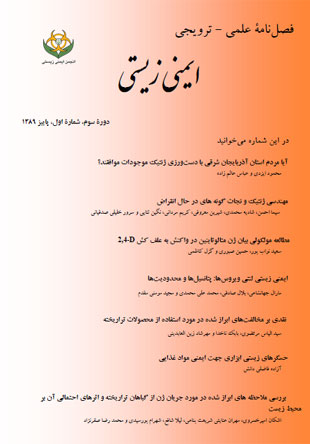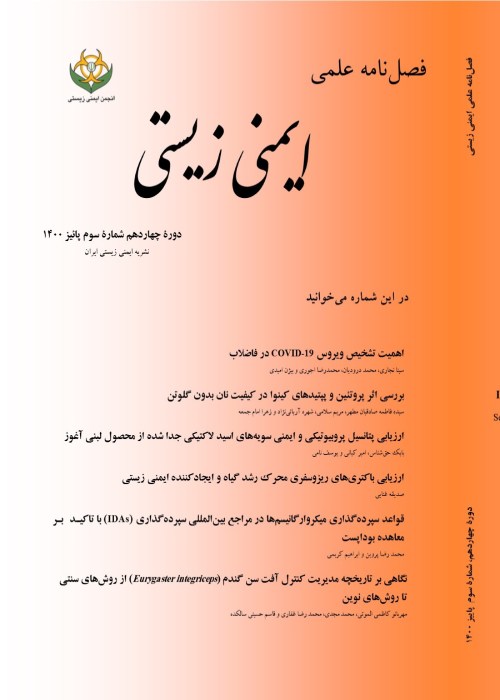فهرست مطالب

فصلنامه ایمنی زیستی
سال سوم شماره 1 (پاییز 1389)
- تاریخ انتشار: 1389/07/20
- تعداد عناوین: 8
-
-
معرفی کتابصفحه 113
-
Page 9To develop genetically modified organisms in different societies it necessary to evaluate the public views in this regard. So in this research, public attitude towards genetically modified organisms and biosafety was evaluated in the East Azarbayjan province in April 2009. This research was conducted using questionnaires containing 39 questions on the 250 people from the East Azarbayjan. Our results show that many participants didn’t know anything about genetically modified organisms. Most of people agreed with the producing and consuming of these organisms and they believed this is necessary to use them in agriculture. Near to %90 of people agreed with the producing of transgenic plants and %76 agreed with transgenic animals. The knowledge of participants in biosafety was less than our estimation. Close to %85 of people were not familiar with regulatory systems for genetically modified organisms. According to these results, we conclude that public perception of the East Azarbayjan about genetically modified organisms were positive and with increasing the knowledge of people about these organisms it is possible to eliminate the present ambiguities and doubts about this issue.Keywords: Azarbayjan Sharghi Province, Biosafety, Biotechnology, Public perception, Genetically Modified Organisms (GMO)
-
Page 25Speed of disappearing animal species convinces most of the zoologists that we are having the sixth big extinction, an extinction which is because of the human activities. Asiatic lion (Panthera Leo Persicus), Persian leopard (Panthera pardus saxicolor), Chita, Vulpes Cana, Alaotra grebe, Palas cat, Polar bear, Koala are endangered of extinction species. So as endangered species are disappearing from natural habitats and are limited to the ones which are found in zoos, researchers are looking for ways to save these species. Genetic engineering introduces new ways of cloning using the technique which created Dolly the sheep; to generate endangered animals in the eggs and wombs of common creatures such as cows. Researchers have opened the door to a future where even extinct species such as mammoths could walk on the earth again. In this article we have tried to show the importance of the subject and present some ways of saving these endangered species in order to draw scientist’s attention to it.Keywords: Asiatic lion, Cloning, Genetic engineering, Polar Bear, Sixth big extinction
-
Page 33Effect of 2-4-D herbicide on metallothionein gene expression in increased resistance of a transgenic Arabidopsis line was evaluated. The transgenic seeds were sown at growth room and were transferred to greenhouse at four leaf stage. Treatments were included 0.05, 0.1, 0.15, 0.2 ml/m2 of 2-4-D herbicide. The treatments were sprayed at three growth stages: rosset stage, flowering and seed producing stages. Physical appearance, seed yield and gene expression was analyzed by using northern blot hybridization. The role of metallothionein gene in cellular function and antioxidate properties has been reported. The results of this study showed over expression of metallothionein gene can increase resistance to 2-4-D herbicide specifically at rapid growth stage (flowering). This could be quite crucial, since using 2-4-D herbicide at final growth stage coincides with high damages of weeds. The best treatment was 0.15 ml/ 2 specially at flowering stage. Based on this results transfering of merallothionein gene to some cereals e.g. wheat, barley would be recommended in order to produce herbicide tolerant crop plants.Keywords: Merallothionein gene, 2, 4, D Herbicide, Gene expression, Relative resistant
-
Page 43Although the strongest lentiviral carriers are derived from the most pathogenic human viruses like HIV, but there are special features in lentiviral vectors such as their ability in entering into cells with or without ability for cell division, long expression and low levels of the induction in host immune system, making these vectors as one of the most ideal carriers for gene transfer and gene therapy. Therefore, research and study on biosafety issues relevant to these Vectors, for laboratory personnel and patients should be carried out. On the other hand, safety assessment of final lentivirus carriers-based products is very important. Development of standard methods to assess safety of these vectors is inevitable since expansion of gene transfer techniques based on lentiviral viruses and suggestion of new methods for applying these vectors in gene therapy is increasing. This review, attempts to survey safety issues relevant to application of lentiviral vectors and their draw backs for genetic engineering.Keywords: Biosafety, Lentivirus, Retrovirus, Immune System
-
Page 53about the socio-economic benefits of these crops. But, still some criticisms about their cultivation and usage can be heard from around the world especially in EU countries. Anti GMOs claim that genetic engineering methods are not natural and there are some concerns about gene escape, religious and ethical issues, intellectual property rights and its effects on economic independency of countries, and ultimately more poverty and social inequilibrity. Moreover, application of antibiotic resistance genes as selectable markers, and Bt genes because of some fears about their toxicity for human being and non-target organisms, and finally, application of herbicide resistance genes because of the risk of gene escape that may lead to super weed production were criticized by the anti-GMOs. Reasons claimed by these groups for their oppositions and appropriate scientific responses to these claims, as well as the main economicreasons behind these criticisms were considered.Keywords: Bt genes, genetic engineering, genetically modified crops, opposition, safety, transformation
-
Page 77Food safety is a global health challenge and the foodborne diseases take a major crisis on human health. Therefore, detection of pathogens in food is necessary in order to prevent and for the for the recognition of problems related to health and safety. Obviously, unfavorable detection methods may take up to several hours or even a few days to yield an answer. Among these methods, new technologies like biosensors show potential approaches, which are able to detect and determine pathogens accurately, rapidly and reliably. This paper provides an overview and introduction of biosensors and, their classification. Application of biosensors in food industry is also described.Keywords: Biosensors, Antibiotics, Toxin, Lactic acid, Bacteria
-
Page 93World’s population is significantly increasing and food needed is decreasing. However, today the progress in the science especially plant biotechnology helps to improve food resources. Therefore, high yield and more stable cultivars are screened. At the moment due to the significant progress in plant biotechnology, limitation regarding genetic manipulations and gene transfer are being disappeared and researchers are capable to do breeding on importanttraits. In spite of advantages obtained by plant biotechnology some concerns still exist such as transfer of foreign genes from transgenic plants to herbs or other special from the same genes. The highest environmental concern regarding the gene flow from transgenics is related to transfer of genes into wild population of plants and its impact on environment. The effect of gene flow on the environment is its introgression into the genome of wild species. In order to block the negative environmental effects of gene flow on weeds and landraces, using gene flow barriers and mitigation of gene flow are very important. Molecular methods for controlling the gene flowbetween crops and weeds are based on maternal inheritance, male sterility and seed sterility. The distance adjustment of cultivation between transgenic and non- transgenic plants in a region could be a suitable strategy to decrease gene flow via pollen. According to these cases and the presence of transgenic crops on the market using this type of product which hascommercial any adverse effect has been not reported. According to the available resources and acreage, these productions annually increase that is embracing the use of these products.Keywords: Gene flow, Plant transgenic, Pollen grain


